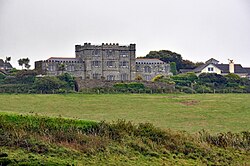Perranuthnoe
| Perranuthnoe | |
| Cornwall | |
|---|---|
 Perranuthnoe church and village | |
| Location | |
| Grid reference: | SW541292 |
| Location: | 50°6’54"N, 5°26’42"W |
| Data | |
| Post town: | Truro |
| Postcode: | TR20 |
| Dialling code: | 01736 |
| Local Government | |
| Council: | Cornwall |
| Parliamentary constituency: |
St Ives |
Perranuthnoe is a village in south-western Cornwall, whose population (over the whole parish) was recorded as 2,184 at the 2011 census. The village is on the eastern side of Mount's Bay approximately one mile east of Marazion and four miles east of Penzance.
Perranuthnoe is within the 'Cornwall Area of Outstanding Natural Beauty', as is almost a third of the county.
History
The first historical mention of Perranuthnoe can be found in the Domesday Book of 1086, as Odenol. By 1235 this had become Hutheno, and was recorded as Udno in 1308 and 1373. Finally taking the form Uthnoe-veor in 1839. There is still a farm in the village called Ednoe-vean.
During the 18th and 19th century the landscape surrounding the village supported a number of tin and copper mines the last of which closed in 1900.
The barque Saluto was wrecked at Cudden Point, Perranuthnoe, in December 1911.[1]
Acton Castle

Acton Castle is a small castellated mansion built about the year 1775 by John Stackhouse of Pendarves, who was a distinguished botanist with an interest in marine algae. Wings of two storeys were added in the 20th century.[2]
Below the castle is Stackhouse Cove where Mr Stackhouse pursued his studies.[3] In 1797 he published his illustrated work Nereis Britannica.[4]
Outside links
| ("Wikimedia Commons" has material about Perranuthnoe) |
References
- ↑ Leonard, Alan (2008), "Profiting from Shipwrecks", Picture Postcard Annual: 14–16
- ↑ Nikolaus Pevsner: The Buildings of England: Cornwall, 1951; 1970 Penguin Books ISBN 978-0-300-09589-0
- ↑ Ralfs, J. (1884) The Marine Algae of West Cornwall. Transactions of the Penzance Natural History and Antiquarian Society. pp. 315-30
- ↑ Turk, S M and Tompsett, P. (2009) The History of Cornish seaweed observers. CISFBR Summer Newsletter 2009.